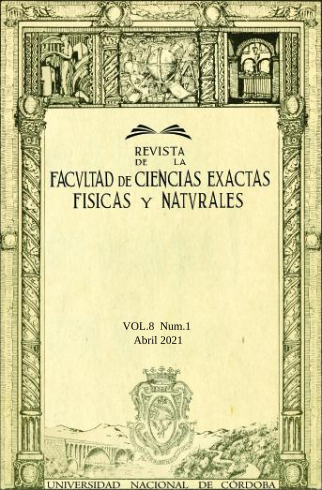Estudio Aerodinámico de Perfiles con Espesor con el Método de Red de Vórtices
Keywords:
Thick Airfoils, Aerodynamics, Point Vortices, Potential FlowAbstract
In this effort, a numerical study is presented regarding the aerodynamic characteristics of wing sections through the vortex lattice method (VLM). The developed computational implementation allows one to simulate steady-state, quasi-steady and unsteady two- dimensional problems. In this article, the estimation error of the computational tool is quantified in terms of the geometry of the wing section: thickness and curvature of the mean line (camber), and of the discretization. It is observed that for the NACA profiles, the error of the estimation of the lift slope increases when the thickness increases but remains bounded between 5 % and 20 % for thicknesses up to 12%. Regarding the camber, the error of the estimation of the lift at zero angle of attack increases with increasing camber and can reach values up to 50%. Finally, for the profile DU97W300, the numerical tool shows a lot of potential since it can predict with high precision the experimental pressure distribution for relatively low angles of attack and also estimates the lift slope and lift for zero angle of attack with an error less than 10%.
Downloads
References
Abbott, I. H. A. y Von Doenhoff, A. E. (1959). Theory of wing sec- tions, including a summary of airfoil data. Dover Publications.
Antman, S. (2005). Nonlinear Problems of Elasticity, volumen 107 de Applied Mathematical Sciences. Springer.
Baldacchino, D., Ferreira, C., Tavernier, D. D., Timmer, W. A., y van Bussel, G. J. W. (2018). “Experimental parameter study for passive vortex generators on a 30% thick airfoil”. Wind Energy, 21(9):745– 765.
Chow, C. Y. y Huang, M. K. (1982). “The initial lift and drag of an impulsively started airfoil of finite thickness”. Journal of Fluid Mechanics, 118:393–409.
Drela, M. (1989). “Xfoil: An analysis and design system for low rey- nolds number airfoils”. En: Low Reynolds number aerodynamics, pp. 1–12. Springer.
Drela, M. y Giles, M. B. (1987). “Viscous-inviscid analysis of transonic and low reynolds number airfoils”. AIAA journal, 25(10):1347–1355.
Graham, J. M. R. (1983). “The lift on an aerofoil in starting flow”. Journal of Fluid Mechanics, 133:413–425.
Jacobs, E., Ward, K., y Pinkerton, R. (1935). “The characteristics of 78 related airfoils sections from tests in the variable-density wind tunnel”. Reporte técnico No 460, National Advisory Commitee for Aeronautics (NACA), Washington D.C.
Katz, J. (2019). “Convergence and accuracy of potential-flow methods”. Journal of Aircraft, 56(6):2371–2375.
Katz, J. y Plotkin, A. (2001). Low-speed aerodynamics. Cambridge university press.
Mook, D. T. y Dong, B. (1994). “Perspective: numerical simulations of wakes and blade-vortex interaction”. J. Fluids Eng., 116(1):5–21.
Prandtl, L. y Tietjens, O. G. (1934). Fundamentals of hydro-and ae- romechanics. Republished by Dover in 1957.
Pullin, D. I. y Perry, A. E. (1980). “Some flow visualization experi- ments on the starting vortex”. Journal of Fluid Mechanics, 97(2):239– 255.
Ramesh, K., Gopalarathnam, A., Granlund, K., Ol, M., y Edwards, J. (2014). “Discrete-vortex method with novel shedding criterion for unsteady aerofoil flows with intermittent leading-edge vortex shed- ding”. Journal of Fluid Mechanics, 751:500.
Roesler, B. T. y Epps, B. P. (2018). “Discretization requirements for vortex lattice methods to match unsteady aerodynamics theory”. AIAA Journal, 56(6):2478–2483.
Rohatgi, A. (2020). “Webplotdigitizer: Version 4.3”.
Saffman, P. G. (1992). Vortex dynamics. Cambridge university press.
Valdez, M. F., Preidikman, S., y Larsen, S. E. F. (2017). “Análisis aerodinámico de perfiles con múltiples superficies para control y re- dirección de flujo”. Mecánica Computacional, 35(26):1517–1539.
Wagner, H. (1925). “Über die entstehung des dynamischen auftriebes von tragflügeln”. ZAMM-Journal of Applied Mathematics and Mecha- nics/Zeitschrift für Angewandte Mathematik und Mechanik, 5(1):17– 35.
Downloads
Published
How to Cite
Issue
Section
License
Copyright (c) 2021 Facultad de Ciencias Exactas, Físicas y Naturales (Universidad Nacional de Córdoba)

This work is licensed under a Creative Commons Attribution 4.0 International License.
Los autores que publican en esta revista están de acuerdo con los siguientes términos:
Los autores conservan los derechos de autor y conceden a la revista el derecho de la primera publicación.
Los autores pueden establecer por separado acuerdos adicionales para la distribución no exclusiva de la versión de la obra publicada en la revista (por ejemplo, situarlo en un repositorio institucional o publicarlo en un libro), con un reconocimiento de su publicación inicial en esta revista.
Se permite y se anima a los autores a difundir sus trabajos electrónicamente (por ejemplo, en repositorios institucionales o en su propio sitio web) antes y durante el proceso de envío, ya que puede dar lugar a intercambios productivos, así como a una citación más temprana y mayor de los trabajos publicados (Véase The Effect of Open Access) (en inglés).



